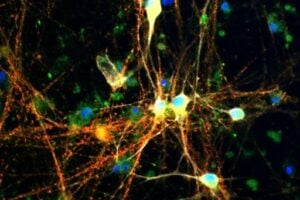Researchers have discovered an important connection between the TREM2 gene and Alzheimer’s disease.
Allan Levey is one of the project’s authors and director of the Emory Alzheimer’s Disease Center of Excellence in Atlanta. He says,
“This gives us another target for the disease. It might turn out to be something that is an ideal target for drug therapy if you could alter it to make it protective.”
The TREM2 gene variant impairs microglia cells. Levey says,
“These (microglia) cells are of two minds. They can help get rid of debris in the brain, or they can cause progressive injury.”
When protective, microglias can prevent inflammation and eliminate amyloid plaque, a substance that attaches to and kills brain cells in many people with Alzheimer’s. The TREM2 variant causes the microglia to become destructive, releasing inflammation causing cytokines and failing to remove plaque. Therefore, another important clue here is that TREM2’s behavior supports the long-held belief that inflammation plays a role in Alzheimer’s.
Technical Details
The large-scale international study involving French researchers from the Inserm-Institut Pasteur Lille-Université Lille Nord de France “Public health and molecular epidemiology of ageing-related diseases” joint research unit led by Philippe Amouyel, discovered the TREM2 gene’s susceptibility to a rare disease that causes susceptibility to the more common Alzheimer’s disease, providing evidence of the heterogeneous aetiology of Alzheimer’s disease.
This whole-exome sequencing approach is explained in detail in The New England Journal of Medicine dated 14 November 2012.
Polycystic lipomembranous osteodysplasia with sclerosing leukoencephalopathy, or Nasu-Hakola disease, is a genetic disorder passed on by means of autosomal recessive transmission. The disease starts at the age of around 30 years with pains in the wrists or shoulders associated with swollen joints. Bone fractures can occur as a result of minor traumas. Bone x-rays show epiphyseal cysts. Slight personality changes then occur followed by frontal neurological signs (euphoria, loss of social inhibitions) evolving into early-onset dementia. The disorder has been associated with mutations of the TREM2 (Triggering Receptor Expressed on Myeloid cells 2) gene on chromosome 6.
British, American and French researchers have now shown that on this same region of chromosome 6, mutations of the TREM2 gene were associated with a five times greater risk of developing late-onset Alzheimer’s disease. A complete sequencing was performed on 281 individuals with Alzheimer’s disease and 504 controls. Analysis of the TREM2 gene showed excessive TREM2 mutations in those with the disease compared with the control subjects. Characterisation of one of these TREM2 mutations in very large sample populations of patients with Alzheimer’s disease has allowed researchers to measure precisely the importance of this association between TREM2 mutations and the disease. Finally, a replication study was performed in another independent series of 1994 cases and 4602 controls, which confirmed this strong association (OR=4.97 CI 95% [2.42-10.21], P<6.10-6).
These results are also confirmed in the same edition of The New England Journal of Medicine by an Icelandic team, which also shows that this gene is a risk factor for Alzheimer’s disease in the Finnish population and other European populations.
A pathological analysis of six individuals presenting variants of the TREM2 gene has revealed evidence of Alzheimer’s-type brain lesions. The study of TREM2 gene expression in normal human brains has shown high levels in the white matter and in the hippocampus and cortex.
In a transgenic mouse model of Alzheimer’s disease, an increase in TREM2 expression was observed in microglial cells surrounding the amyloid plaques and the neurons compared with normal mice. The TREM2 gene encodes a protein that participates in the activation of immune responses in macrophages and dendritic cells.
This discovery has two main consequences. Firstly, this observation provides a better understanding of the immune system’s involvement in Alzheimer’s disease in which the gene of complement receptor 1 (CR1) had already been implicated, in previous work by Inserm-Lille2-IPL UMR744 . Furthermore, this approach of whole-exome sequencing has allowed the discovery of a gene for susceptibility to a rare disease that causes susceptibility to a common disease, evidence of the heterogeneous aetiology of Alzheimer’s disease. It is the loss of function of this gene in its homozygous or heterozygous variants that determines the nature of the disorder.
These results, which demonstrate how much progress has been made in understanding Alzheimer’s disease, involved teams from LabEx DISTALZ, and were able to be produced partly through the support of the French Foundation for Scientific Cooperation on Alzheimer’s and similar diseases.











